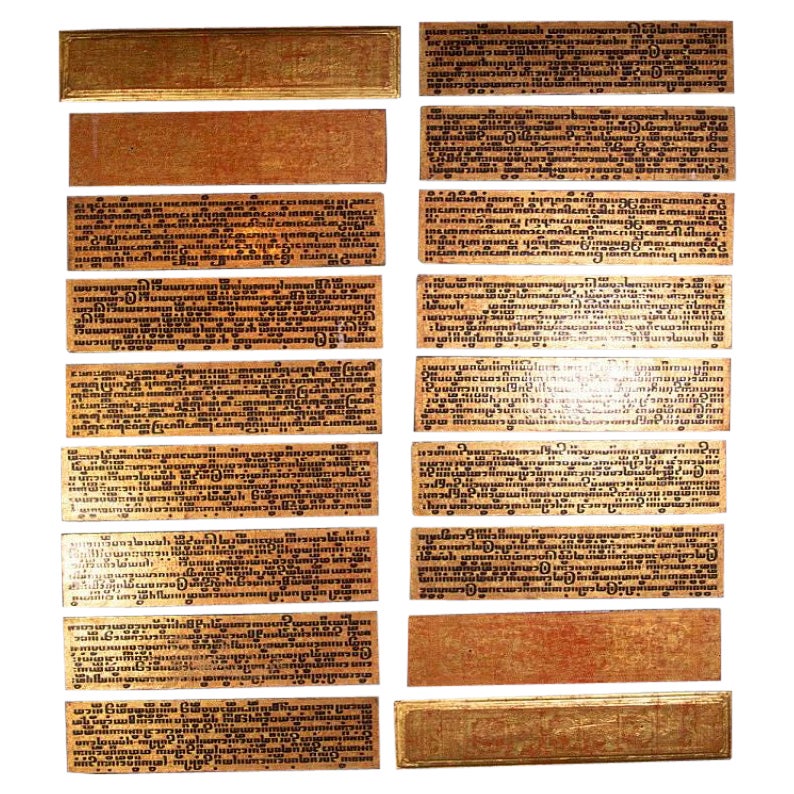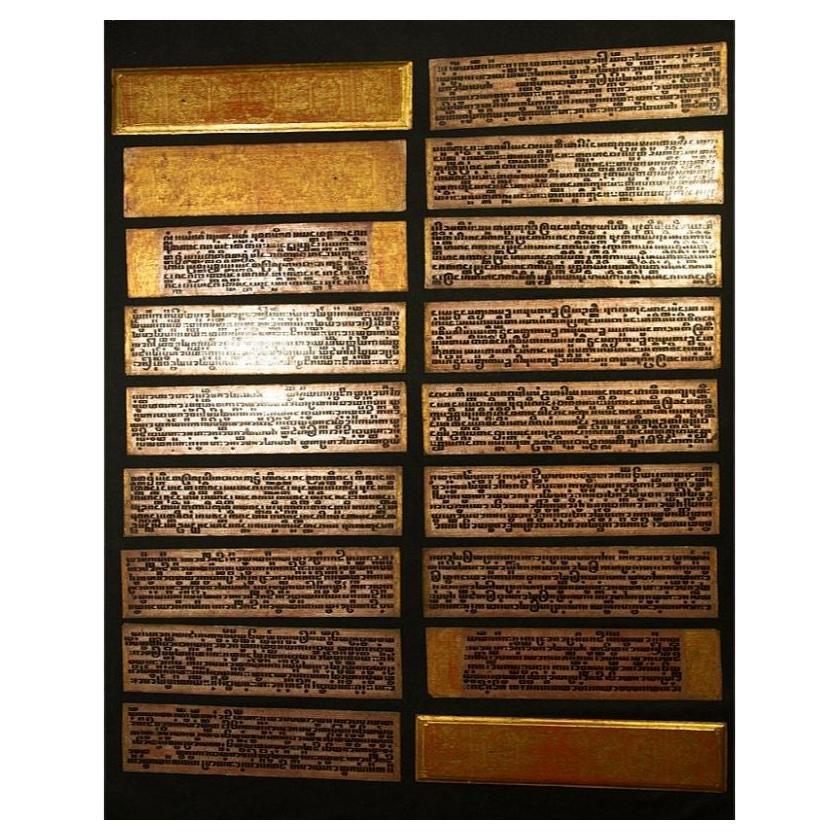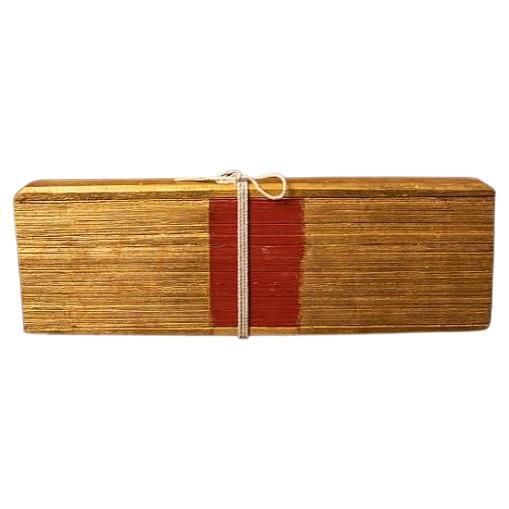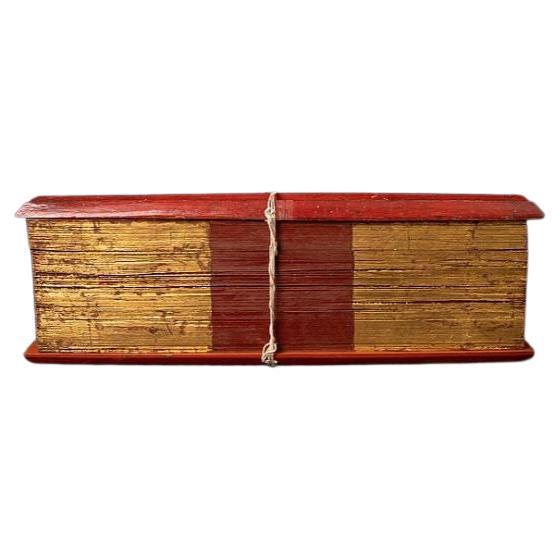Items Similar to Book : Myanmar Buddhist Imagery by Denis Lepage from Belgium
Video Loading
Want more images or videos?
Request additional images or videos from the seller
1 of 21
Book : Myanmar Buddhist Imagery by Denis Lepage from Belgium
About the Item
Material: Book
3 cm high
26 cm wide and 26 cm high
A great up-to-date view and correct book of Myanmar Buddhist arts with lots of high quality images and correct descriptions
With lots of unique and beautiful images of statues from several National Myanmar Museums
491 pages with more than 1200 illustrations
Weight: 2 kgs
Originating from Belgium
Nr: DP-01
- Dimensions:Height: 1.19 in (3 cm)Width: 10.24 in (26 cm)Depth: 10.24 in (26 cm)
- Materials and Techniques:
- Place of Origin:
- Period:
- Date of Manufacture:Newly Made
- Production Type:New & Custom(Current Production)
- Estimated Production Time:Available Now
- Condition:Wear consistent with age and use.
- Seller Location:DEVENTER, NL
- Reference Number:
About the Seller
5.0
Gold Seller
These expertly vetted sellers are highly rated and consistently exceed customer expectations.
Established in 1997
1stDibs seller since 2022
20 sales on 1stDibs
Typical response time: 9 hours
- ShippingRetrieving quote...Ships From: DEVENTER, Netherlands
- Return PolicyA return for this item may be initiated within 14 days of delivery.
More From This SellerView All
- Antique Burmese Manuscript, Kammavaca Book from BurmaLocated in DEVENTER, NLMaterial: Lacquered palm leaves Material: wood Measures: 5 cm high 52,5 cm long and 11,5 cm wide Each page is gilded with 24 krt. gold Shan (Tai Yai) style Originating from Bu...Category
Antique 19th Century Burmese Sculptures and Carvings
MaterialsWood
- Antique Burmese Manuscript, Kammavaca Book from BurmaLocated in DEVENTER, NLMaterial: Lacquered palm leaves Material: wood 3,5 cm high 54 cm long and 12 cm wide Gilded with 24 krt. gold and also partly silver plated Mandalay style Originating from Bur...Category
Antique 19th Century Burmese Sculptures and Carvings
MaterialsWood
- Antique Palm Leave Manuscript Book from BurmaLocated in DEVENTER, NLMaterial: Palm leaves & wood Material: wood 15,5 cm high 45,5 cm wide and 4,3 cm deep Weight: 1.458 kgs Gilded with 24 krt. gold Originating from Burma 19th century Many pages, made of Palm leaves covered with 2 wooden covers. Is also being called a 'Parabaik'. The text is written in Pali language, an ancient Buddhist...Category
Antique 19th Century Burmese Sculptures and Carvings
MaterialsWood
- Antique Palm Leave Manuscript Book from, BurmaLocated in DEVENTER, NLMaterial: palm leaves & wood. Material: wood. Measures: 14, 9 cm high. 45 cm wide and 6 cm deep. Weight: 1.998 kgs. Gilded with 24 krt. gold. Originating from Burma. 19th Cent...Category
Antique 19th Century Burmese Sculptures and Carvings
MaterialsWood
- Antique Palm Leave Manuscript Book from, BurmaLocated in DEVENTER, NLMaterial: palm leaves & wood. Material: wood. Measures: 16 cm high. 49 cm wide and 6, 5 cm deep. Weight: 1.864 kgs. Gilded with 24 krt gold. Originating from Burma. 19th Cent...Category
Antique 19th Century Burmese Sculptures and Carvings
MaterialsWood
- Antique Burmese Opiumweight from BurmaLocated in DEVENTER, NLMaterial: bronze 2,6 cm high 2 cm wide and 2 cm deep Weight: 0.032 kgs Originating from Burma 18th centuryCategory
Antique 18th Century Burmese Sculptures and Carvings
MaterialsBronze
You May Also Like
- Japanese Wood Gilt Lacquer Buddha Buddhist Temple Traveling Zushi Shrine AltarLocated in Studio City, CAA wonderful Japanese Buddhist portable traveling zushi shrine altar with Amida Buddha (Amitabha) concealed inside the folded wood doors. This work dat...Category
Early 20th Century Japanese Showa Sculptures and Carvings
MaterialsMetal, Gold Leaf
- Japanese Temple Buddhist Monk Samurai Juzu Prayer Beads Mala Rosary NecklaceLocated in Studio City, CAA truly magnificent and special work - this beautiful and exceptionally long string of Japanese hand-crafted natural wood (perhaps Rosewood) Buddhist Juzu mala beads. These rosary-type large prayer bead necklaces were used by Buddhist monks in temple prayers/rituals and worn by Samurai as amulets of protection. During the Edo period, Buddhist priests/monks and samurai warriors used to wrap the beads around their bodies and use the beads in their worshipping and meditation ceremonies. After reading the sutra once, one bead would be moved (some sects used them instead of wooden tally counters). It would take a tremendous amount of intense concentration and physical stamina to read the sutra while holding and counting/moving each individual prayer bead as well as a copious amount of time to move all the prayer beads to complete the sutra cycle. We have not come across another set of Juzu beads...Category
Antique Early 19th Century Japanese Edo Sculptures and Carvings
MaterialsWood
- Japanese Temple Shrine Buddhist Monk Juzu Prayer Wood Beads Mala Rosary NecklaceLocated in Studio City, CAA truly magnificent and special work - this beautiful and exceptionally long string of Japanese handcrafted natural wood (perhaps rosewood) Buddhist Juzu mala beads with four large square-like beads called shitenshu beads said to represent the Four Heavenly Kings: Jikko-Ten, Zocho-ten, Hiromoku-ten, and Tamon-ten (Since there are four square beads, the denomination is probably Tendai or Nichiren sect). These rosary-type prayer bead necklaces were used by Buddhist monks in temple prayers / rituals and worn by Samurai as amulets of protection. We have not come across another set of Juzu beads...Category
Antique 19th Century Japanese Meiji Sculptures and Carvings
MaterialsWood
- 400-600 Year Old Burmese Sandstone Stupa Pagoda SculptureLocated in Kastrup, DKRare stupa sculpture, 400-600 years old, carved in sandstone. In original untouched, well-preserved condition. From Arakan in Burma. Typical stupa construction with square base, hemispherical dome and conical spire. At the base a portal door...Category
Antique 16th Century Burmese Other Sculptures and Carvings
MaterialsSandstone
- Large Burmese Bronze Medicine Buddha, Pagan Style, Late 19th CenturyLocated in Austin, TXA large and magnificent cast bronze image of the Medicine Buddha, Bhaisajyaguru, rendered in the Burmese Pagan style, and most likely based on a period example that was either damaged or lost, 19th century, Burma or Thailand. He can be identified as the Medicine Buddha by the hand that rests in his lap, with his middle finger touching the thumb. A medicine pot or fruit stem would originally have been placed in his upturned palm. The face of this Buddha has been sculpted masterfully. He has a beautiful heart shaped face topped by hair neatly arranged in the typical "snail shell curls", and surmounted by a high ushnisha. Long, pendulous earlobes frame his face, a symbol of his princely past. He gazes serenely outwards from heavily lidded, downcast eyes, a content smile upon his full, lush lips. The Buddha is portrayed seated in vajrasana (full lotus position), his elegant hands displayed in varada mudra, the gesture of granting favors and fulfilling wishes. Long, exquisite fingers extended, the thumb and middle finger touching in a gesture of compassion. He is clothed in a simple kasaya wrapped around his body and over one shoulder, leaving the shoulder and part of his chest bare. The diaphanous garment clings to his body, outlining his well proportioned and graceful, almost sensuous, form. The excess material pooled in neat pleats in front of him. A sash thrown over his shoulder. He sits upon a double lotus base upon a raised platform. The platform features two kneeling attendants, usually interpreted as the monks Ananda and Kasyapa. Between them is a circular disc representing the Wheel of Dharma. Contained in the disk is a flower with eight petals, symbolizing the eightfold path, one of the principle teachings of the Buddha. The sides and back of the platform featuring a series of singha, or lions, representative of the Buddha's royal past. An applied lacquer patina covers the entirety of the image. Large deposits of ash (from incense) are present between the curls of the hair, as well as some the other crevices, indicating this image was the subject of worship for many years. Bhaisajyaguru, also called the Medicine Buddha, or Buddha of Healing, is a revered figure in the Buddhist pantheon as a master able to cure suffering, both physical and spiritual, through his teachings. The Pagan Empire ruled most of present day Burma (Myanmar) from 849 to 1297. The capital, Bagan, served as a both the center of government and religion, where Buddhism reigned supreme. Bagan was also at a crossroads of the Buddhist world, with influence from India, Nepal, Tibet, China, and even Indonesia shaping their culture. As such, Pagan Buddha...Category
Antique Late 19th Century Burmese Sculptures and Carvings
MaterialsBronze
- Burmese Mandalay Style Gilt Lacquered Buddha & Red Lacquer Covered Baluster VaseLocated in Ottawa, OntarioA Burmese Mandalay style gilt lacquered wood standing figure of Buddha and together with an unusual Burmese red lacquer covered baluster offering vas...Category
20th Century Burmese Chinese Export Sculptures and Carvings
MaterialsWood, Lacquer
Recently Viewed
View AllMore Ways To Browse
Amber Netsuke
Ming Dynasty Pottery Figures
Wealth Laughing Golden Buddha
Luo Brothers
Peace Finger Statue
Jo And Uba
Japanese Meiji Okimono
Japanese Figurines 1920s
Thailand Artifact
Carved Laughing Buddha
Vintage Japanese Wood
Jade Dragon Statue
Antique Chinese Opera Dolls
Chinese Opera Dolls Antique
Asian Cork Diorama
Buddha Head On Wooden Stand
Creative Kokeshi
Statues Java





